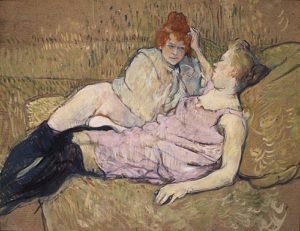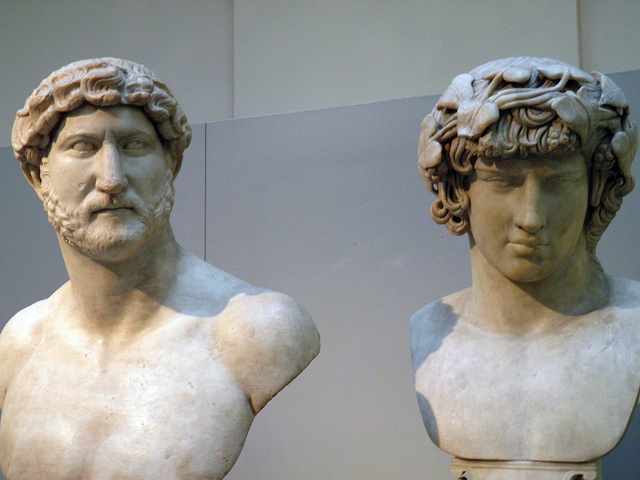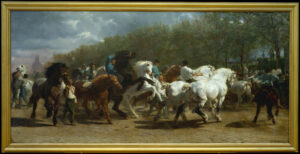Wewerethere.org is a nonprofit dedicated to educating people about LGBTQ+ history, culture, and art. We have some big projects on the horizon, including a TV series on LGBTQ+ history that we are developing with actor and author Stephen Fry. In the day-to-day world, our main activity is giving tours and virtual presentations on LGBTQ+ history and art to groups—school groups, library groups, corporate affinity groups.
Most of our presentations are based in art museums, where they focus on artworks with LGBTQ+ themes, connections etc. We work in museums, because they (or many of them) contain an amazing number of works with LGBTQ+ stories—and also because people are unaware of this, and the museums generally don’t tell these stories.
In effect, the point of all our presentations is the same: many straight, cisgender people seem to think that diverse sexualities and non-conforming gender presentations are something new and that they shouldn’t have to tolerate these new and abnormal developments. And even LGBTQ+ people are often only vestigially aware of the LGBTQ+ past. In fact, however, human beings are inherently diverse, and our gender identities and sexualities are complex and varied.
There have been same sex-sex desires and relationships since the dawn of time: there are even cave paintings showing male-male relations! And the same is true for complexities of gender identity. Indeed, some past cultures categorized sexuality and gender in ways strikingly different from traditional modern Western ones and valorized sexualities and gender identities that would seem “new” and abnormal to modern people.
And one of the best places to learn about this is in the art museum. Sex, sexiness, sexuality, and gender are all important themes in art and motivations for artistic creation, and museums contain records of the different sexualities and gender identities valorized and practiced by different societies and individuals through history. But of course it’s all pretty much hidden from the modern viewer, because we don’t know enough about the societies and artistic traditions to interpret it on our own, and museums are generally complicit in the world-wide conspiracy to de-gay history, so they provide us with opaque hints at best.
Enter wewerethere.org. We explain the art in museums to you to reconnect people to the LGBTQ+ stories and histories behind and around it. And in doing so, we turn museums around: instead of helping to confirm a straight, cis-gender past, they become what they really are, places full of the complex and fascinating lives of our ancestors, waiting to speak to us and affirm us through our connection to the past and to the realm of art.
To give you a more concrete idea of what we’re talking about, here are some examples from the “LGBTQ+ Secrets” tour of the Metropolitan Museum in NYC. The Met is a fantastic museum for this type of tour. People say it is an encyclopedic museum, but it would be more accurate to say it is *the* encyclopedic museum par excellence. While most other museums have some kind of defined mission or certain strong collections that give them an identity, the Met, with its huge size and the vast fortunes behind it, collects art of all periods, all traditions, all genres—even jewelry, costumes, arms and armor, and musical instruments. The result is that it is a great place to follow themes in human history from culture to culture.
And it is particularly rich in LGBTQ+ themes—while unsurprisingly the museum makes no effort to point them out to the public. Indeed, even when it does take a baby step in that direction, such as placing busts of the Roman Emperor Hadrian right across from the bust of his young male lover Antinous, the museum avoids pointing out the reason for their placement to the public.
As anyone interested in women’s history knows, the private lives of historical women are harder to research than the private lives of men. This is doubly true of lesbian love, which takes place in private without any men present. The relative absence of lesbian relations in the historical record reminds us how rarely we hear women’s voices in history, but it also has a positive side: it reminds us that women’s same-sex relations have rarely been criminalized in the way in which many cultures have criminalized men’s same-sex relations.
The Met, luckily, contains a number of works on lesbian themes, such as this painting of 2 tired prostitutes in a brothel. The work, Toulouse-Lautrec’s “The Sofa” (1894-96) is stridently unsexy. The women are rumpled, presumably at the end of a long work day (or night!). And its emphasis is not on sex: the viewer’s eye is drawn  up to the look passing between the two women, a look of intimate complicity and commiseration. It is however also the case the one of the two women is wearing no underwear, clearly indicating that their intimacy includes a sexual side. In fact, lesbianism was a big theme in French cultures of the later 19th century, appearing in artworks by Courbet, poems by Baudelaire, etc. And it was a favorite theme of Toulouse-Lautrec’s. But this work may present the most complete statement of his vision of lesbian relations.
up to the look passing between the two women, a look of intimate complicity and commiseration. It is however also the case the one of the two women is wearing no underwear, clearly indicating that their intimacy includes a sexual side. In fact, lesbianism was a big theme in French cultures of the later 19th century, appearing in artworks by Courbet, poems by Baudelaire, etc. And it was a favorite theme of Toulouse-Lautrec’s. But this work may present the most complete statement of his vision of lesbian relations.
Trans people are even harder to find in history than lesbians—because in general the idea of gender identity had not developed in the way it has in our culture, and while a number of people dressed in clothing considered appropriate to the other sex, we generally do not know enough to judge their motivations. An interesting case is the French woman painter Rosa Bonheur (1822-1899). In the 19th century, it became acceptable, at least in the Bohemian side of the bourgeoisie, for women, instead of marrying a man, to live in a household with another woman; these relationships are called “Boston marriages” (after a relationship in Henry James’ novel The Bostonians). These relationships were generally treated as non-romantic/sexual, but it seems likely that many of them were instead lesbian relationships. Indeed, in some cases (such as the relationship portrayed in the TV series Gentleman Jack), we know that they were. This also seems likely in Rosa Bonheur’s case, but in any case, she spent her adult life in two such relationships. She also challenged gender conventions in a number of ways.
She painted scenes, like this one, of powerful animals in a muscular manner then considered masculine. She also often dressed in men’s clothing. In fact, she was one of twelve women in France who sought and received legal permission to dress in men’s clothing, in a day when this was generally illegal. This painting, her most famous, seems to hint at her seeing this as a statement of identity: she has placed a self-portrait, in men’s clothing, in the middle of a painting probably intended as a capstone to her career. She sits in the middle of the scene of a horse fair, unengaged, gazing out at the viewer with a coy expression, as if to tease the viewer as s/he pieces together this central figure’s identity. It is impossible to establish exactly what that identity was: she could for instance have been intersex. But her identity is at issue here, and it is in some relationship to a modern trans identity.
Male-male relations are a bigger theme in the collection that anything else of the LGBTQ+ spectrum. This is true because such relations have been valorized—and the subject of intense cultural interest and production—in several cultures, from ancient Greece to Edo-period Japan to modern tribal New Guinea. They have also been an important theme in modern Western art, even in times when the culture at large disapproved or even criminalized them.
Hadrian and Antinous, mentioned above, are by no means the earliest male-male couple in the museum. But they are the earliest named couple. And they are widely represented. Both are among the most represented individuals from Classical Antiquity (along with Julius and Augustus Caesar). This is of course not unexpected for Hadrian, who was one of the most important Roman emperors. But Antinous? Most emperors had mistresses and/or male “favorites,” but only Antinous appears frequently in art. And this is so for an astonishing reason: when Antinous died (by drowning in the Nile about the age of nineteen) Hadrian had him declared a god, and it seems that his worship was a popular cult throughout the Empire for the next 300 years!
Want to know more? Sign up for wewerethere.org’s mailing list and social media! Watch our virtual presentations; organize one for your group; and get ready for our TV series!


